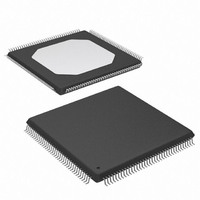XC3S250E-4TQG144I Xilinx Inc, XC3S250E-4TQG144I Datasheet - Page 109

XC3S250E-4TQG144I
Manufacturer Part Number
XC3S250E-4TQG144I
Description
FPGA Spartan®-3E Family 250K Gates 5508 Cells 572MHz 90nm (CMOS) Technology 1.2V 144-Pin TQFP
Manufacturer
Xilinx Inc
Series
Spartan™-3Er
Datasheet
1.XC3S100E-4VQG100C.pdf
(233 pages)
Specifications of XC3S250E-4TQG144I
Package
144TQFP
Family Name
Spartan®-3E
Device Logic Cells
5508
Device Logic Units
612
Device System Gates
250000
Number Of Registers
4896
Maximum Internal Frequency
572 MHz
Typical Operating Supply Voltage
1.2 V
Maximum Number Of User I/os
108
Ram Bits
221184
Number Of Logic Elements/cells
5508
Number Of Labs/clbs
612
Total Ram Bits
221184
Number Of I /o
108
Number Of Gates
250000
Voltage - Supply
1.14 V ~ 1.26 V
Mounting Type
Surface Mount
Operating Temperature
-40°C ~ 100°C
Package / Case
144-LQFP
Lead Free Status / RoHS Status
Lead free / RoHS Compliant
For Use With
813-1009 - MODULE USB-TO-FPGA TOOL W/MANUAL
Lead Free Status / RoHS Status
Lead free / RoHS Compliant
Available stocks
Company
Part Number
Manufacturer
Quantity
Price
Company:
Part Number:
XC3S250E-4TQG144I
Manufacturer:
XILINX
Quantity:
1 670
Company:
Part Number:
XC3S250E-4TQG144I
Manufacturer:
XILINX
Quantity:
284
Company:
Part Number:
XC3S250E-4TQG144I
Manufacturer:
Xilinx Inc
Quantity:
10 000
Part Number:
XC3S250E-4TQG144I
Manufacturer:
XILINX/赛灵思
Quantity:
20 000
Bitstream Generator (BitGen) Options
For additional information, refer to the “Configuration Bit-
stream Generator (BitGen) Settings” chapter in UG332.
Various Spartan-3E FPGA functions are controlled by spe-
cific bits in the configuration bitstream image. These values
Table 69: Spartan-3E FPGA Bitstream Generator (BitGen) Options
DS312-2 (v3.8) August 26, 2009
Product Specification
ConfigRate
StartupClk
UnusedPin
DONE_cycle
GWE_cycle
GTS_cycle
LCK_cycle
Option Name
R
Pins/Function
Configuration,
shift registers,
Configuration
Configuration
Configuration
Configuration
Configuration
All flip-flops,
Block RAM,
LUT RAMs,
All I/O pins,
Unused I/O
and SRL16
DONE pin,
Affected
Startup
Startup
Startup
Startup
DCMs,
CCLK,
Pins
12, 25, 50
Pulldown
1, 2, 3, 4,
1, 2, 3, 4,
1, 2, 3, 4,
0, 1, 2, 3,
(default)
Pullnone
UserClk
NoWait
Values
1, 3, 6,
Pullup
4, 5, 6
Done
Keep
Done
Keep
Cclk
Jtag
5, 6
5, 6
5, 6
Sets the approximate frequency, in MHz, of the internal oscillator using for Master
Serial, SPI, and BPI configuration modes. The internal oscillator powers up at its lowest
frequency, and the new setting is loaded as part of the configuration bitstream. The
software default value is 1 (~1.5 MHz) starting with ISE 8.1, Service Pack 1.
Default. The CCLK signal (internally or externally generated) controls the startup
sequence when the FPGA transitions from configuration mode to the user mode. See
Start-Up.
A clock signal from within the FPGA application controls the startup sequence when
the FPGA transitions from configuration mode to the user mode. See Start-Up. The
FPGA application supplies the user clock on the CLK pin on the
STARTUP_SPARTAN3E primitive.
The JTAG TCK input controls the startup sequence when the FPGA transitions from
the configuration mode to the user mode. See Start-Up.
Default. All unused I/O pins and input-only pins have a pull-down resistor to GND.
All unused I/O pins and input-only pins have a pull-up resistor to the VCCO_# supply
for its associated I/O bank.
All unused I/O pins and input-only pins are left floating (Hi-Z, high-impedance,
three-state). Use external pull-up or pull-down resistors or logic to apply a valid signal
level.
Selects the Configuration Startup phase that activates the FPGA’s DONE pin. See
Start-Up.
Selects the Configuration Startup phase that asserts the internal write-enable signal to
all flip-flops, LUT RAMs and shift registers (SRL16). It also enables block RAM read
and write operations. See Start-Up.
Waits for the DONE pin input to go High before asserting the internal write-enable
signal to all flip-flops, LUT RAMs and shift registers (SRL16). Block RAM read and
write operations are enabled at this time.
Retains the current GWE_cycle setting for partial reconfiguration applications.
Selects the Configuration Startup phase that releases the internal three-state control,
holding all I/O buffers in high-impedance (Hi-Z). Output buffers actively drive, if so
configured, after this point. See Start-Up.
Waits for the DONE pin input to go High before releasing the internal three-state
control, holding all I/O buffers in high-impedance (Hi-Z). Output buffers actively drive,
if so configured, after this point.
Retains the current GTS_cycle setting for partial reconfiguration applications.
The FPGA does not wait for selected DCMs to lock before completing configuration.
If one or more DCMs in the design have the STARTUP_WAIT attribute set to TRUE,
the FPGA waits for such DCMs to acquire their respective input clock and assert their
LOCKED output. This setting selects the Configuration Startup phase where the FPGA
waits for the DCMs to lock.
www.xilinx.com
are specified when creating the bitstream image with the
Bitstream Generator (BitGen) software.
Table 69
FPGAs.
provides a list of all BitGen options for Spartan-3E
Description
Functional Description
109

















